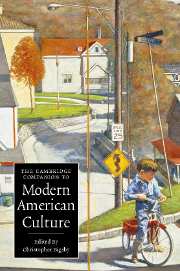Book contents
- Frontmatter
- 1 Introduction: What, then, is the American?
- 2 The American century
- 3 The regions and regionalism
- 4 Immigration to the United States in the twentieth century
- 5 Religion in the United States in the twentieth century: 1900-1960
- 6 Shifting boundaries: religion and the United States: 1960 to the present
- 7 The Hispanic background of the United States
- 8 African Americans since 1900
- 9 Asian Americans
- 10 Women in the twentieth century
- 11 Queer America
- 12 The United States, war, and the twentieth century
- 13 The culture of the Cold War
- 14 Secret America: the CIA and American culture
- 15 Vietnam and the 1960s
- 16 New York City and the struggle of the modern
- 17 Music: sound: technology
- 18 African American music of the twentieth century
- 19 Hollywood cinema
- 20 Popular culture
- 21 Theatre
- 22 Society and the novel in twentieth-century America
- 23 “Preferring the wrong way”: mapping the ethical diversity of US twentieth-century poetry
- Index
- Series List
6 - Shifting boundaries: religion and the United States: 1960 to the present
Published online by Cambridge University Press: 28 January 2007
- Frontmatter
- 1 Introduction: What, then, is the American?
- 2 The American century
- 3 The regions and regionalism
- 4 Immigration to the United States in the twentieth century
- 5 Religion in the United States in the twentieth century: 1900-1960
- 6 Shifting boundaries: religion and the United States: 1960 to the present
- 7 The Hispanic background of the United States
- 8 African Americans since 1900
- 9 Asian Americans
- 10 Women in the twentieth century
- 11 Queer America
- 12 The United States, war, and the twentieth century
- 13 The culture of the Cold War
- 14 Secret America: the CIA and American culture
- 15 Vietnam and the 1960s
- 16 New York City and the struggle of the modern
- 17 Music: sound: technology
- 18 African American music of the twentieth century
- 19 Hollywood cinema
- 20 Popular culture
- 21 Theatre
- 22 Society and the novel in twentieth-century America
- 23 “Preferring the wrong way”: mapping the ethical diversity of US twentieth-century poetry
- Index
- Series List
Summary
Religion in the United States currently takes on a very visible - and in ways puzzling and disturbing - role in public life. In 2004, George W. Bush was re-elected President of the United States with strong support from evangelical Christians. His God-and-country rhetoric and support for government funding of faith communities signaled a worrisome alliance between political neoconservatives and evangelical Christianity and led to a blurring of boundaries between religion and government, despite an official legal separation of church and state. To critics, it looked, and looks, as if a national religion has been “institutionalized.”
Recent developments have spurred secular reaction. One of the clearest signs of the reaction was the lawsuit brought to the Supreme Court in 2004 by Michael Newdow, an atheist who charged that the phrase “a nation under God” in the pledge of allegiance as it was recited in public schools violated the separation of church and state and was therefore unconstitutional. Though the court has not ruled on the substance of the case, it has spawned considerable controversy touching on what amounts to a sensitive and unresolved issue in American national identity.
- Type
- Chapter
- Information
- The Cambridge Companion to Modern American Culture , pp. 113 - 134Publisher: Cambridge University PressPrint publication year: 2006



